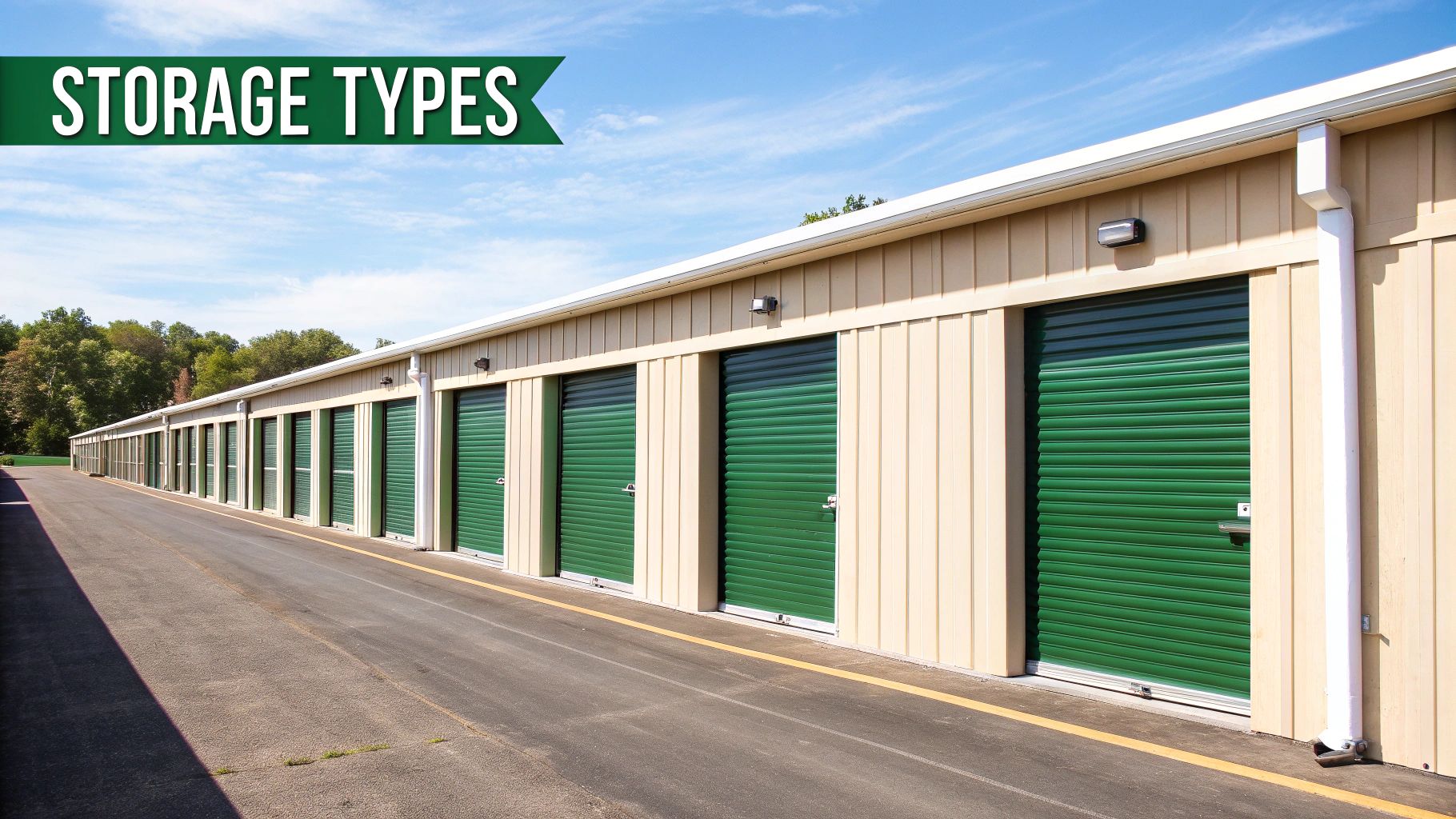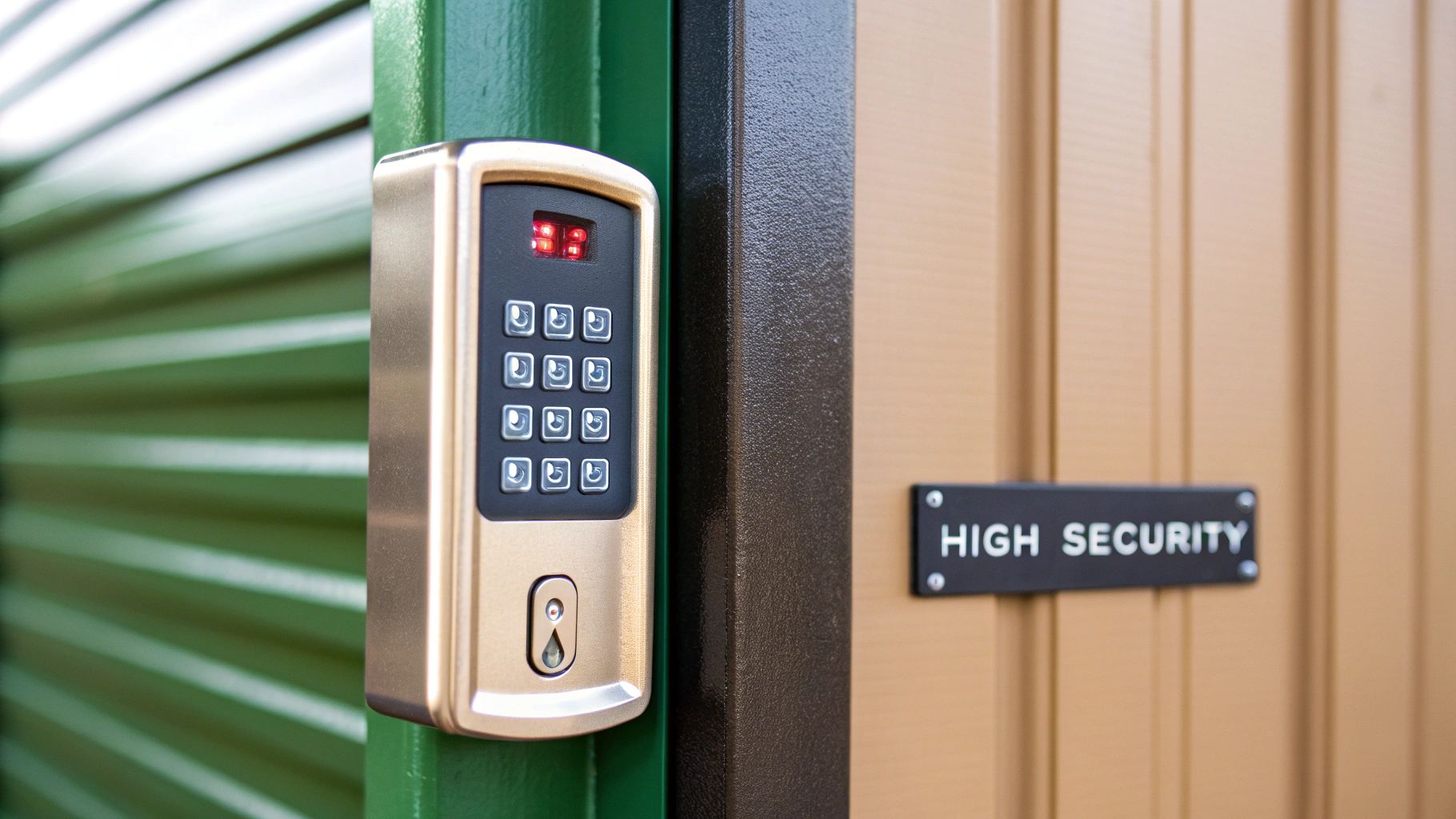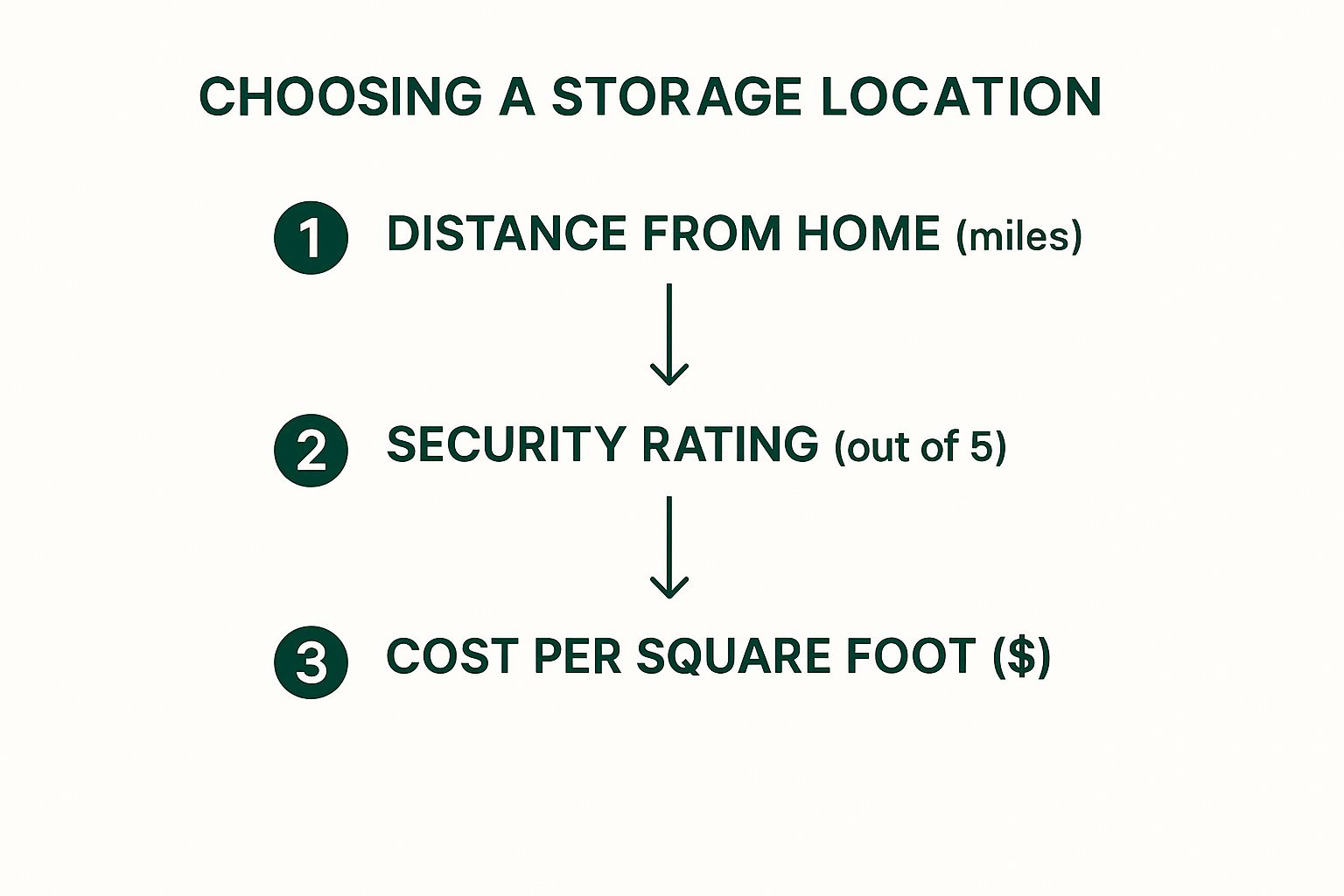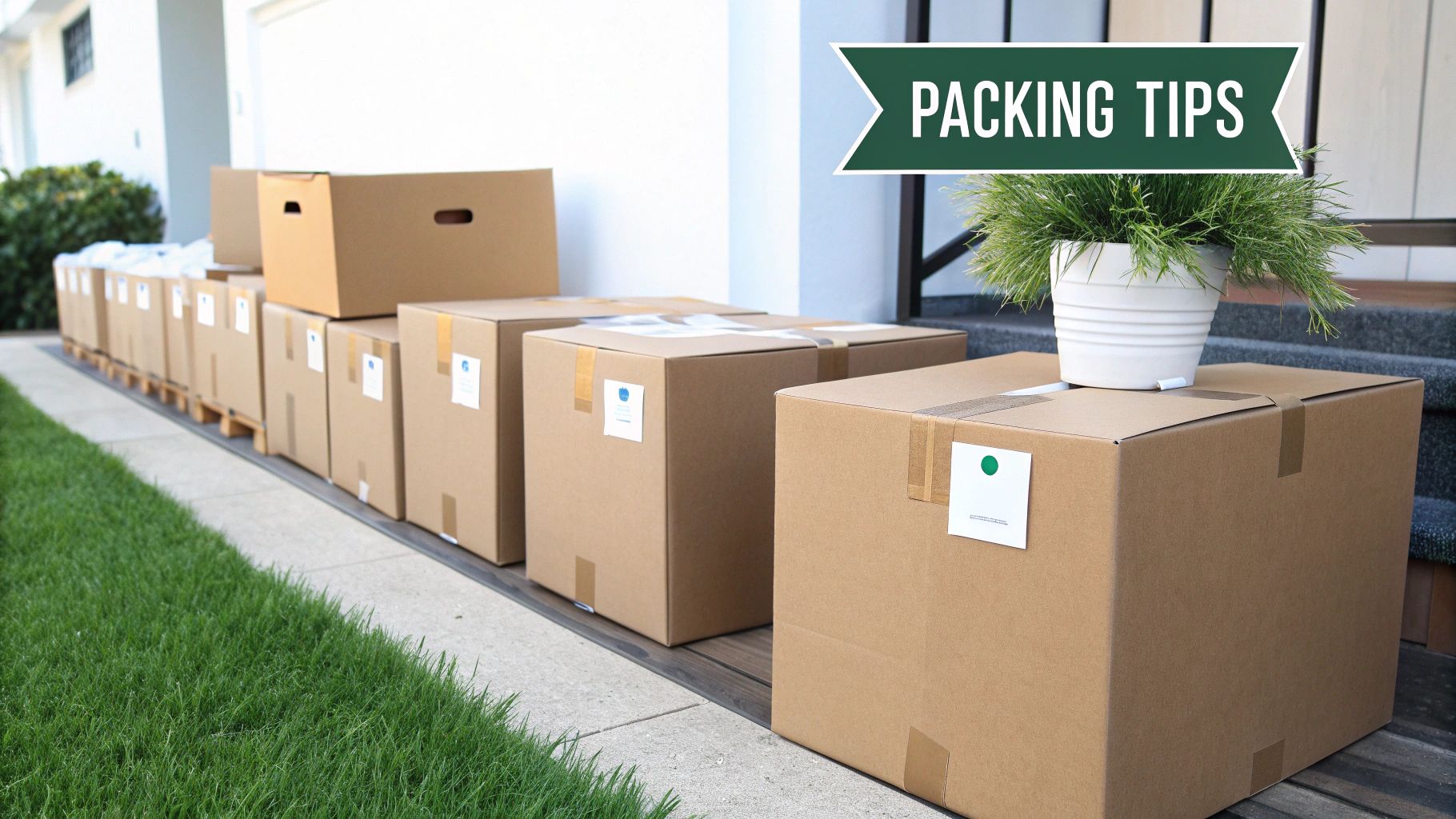Finding Secure Storage Near Me: A UK Guide
When life changes, whether you're moving house, finally tackling that decluttering project, or needing a place for business stock, the search for “secure storage near me” isn't far behind. But here's the thing: finding a facility that truly protects your belongings means digging a bit deeper than a quick map search. You need to compare more than just the price tag and how close it is to home.
This guide is designed to be your practical roadmap, helping you find a self-storage solution you can genuinely trust.
Your Search For Secure Storage Starts Here

Finding the right storage unit is about so much more than proximity. It's about feeling confident that your things are safe, knowing you can get to them when you need to, and not getting stung by hidden clauses in the contract. We're going to skip the obvious and get straight to what really matters.
Think of this as your inside guide, cutting through the marketing fluff to focus on the details that are easy to miss online. We'll look at what real security looks like, why access hours can make or break your experience, and how to spot contract terms that might cause headaches later.
Why The Right Storage Matters
It's no surprise that self-storage is often linked to big life events. Here in the UK, a whopping 44% of people use self-storage because they're moving house, a big jump from 32% the previous year. This just goes to show how crucial it is to find a reliable local spot during those already stressful times.
So, what should you be looking for beyond just a convenient location?
- Real-Deal Security: Don't just settle for a padlock and a fence. Look for layers of protection, like monitored CCTV, coded gate entry, and even individually alarmed units.
- Honest Pricing: You need to know the full cost upfront. Ask about any extra fees for insurance, deposits, or locks before you sign anything.
- Accessibility and Upkeep: Make sure the access hours actually fit your schedule. A quick visit will also tell you if the facility is clean, dry, and well-maintained – all good signs.
Choosing the right storage is an investment in peace of mind. The goal isn't just to find a space, but to find a secure environment where you feel confident leaving your valued possessions, whether for a month or a year.
Our detailed guide will walk you through how to properly evaluate these factors and more, making sure you find a solution that offers genuine security and value for your money.
What Real Security Looks Like at a UK Storage Facility

Pretty much every storage company you come across will tell you they’re ‘secure’. But what does that word actually mean when it comes to your belongings? From years of experience, I can tell you that real security isn’t just about having a decent padlock on the door. It’s a complete, multi-layered system designed to stop problems before they even start.
So, when you're typing "secure storage near me" into a search bar, you need to know what to look for. It's about spotting tangible features that show a real commitment to protection, not just vague marketing promises. A properly secure facility is built on several pillars of protection, all working together.
Beyond The Basics: Surveillance and Access
One of the first things to investigate is their surveillance setup. Don't be fobbed off by a simple sign that says "CCTV in operation." You need to dig deeper. Ask them if the cameras are monitored 24/7 in real-time. This is a huge deal. A monitored system means someone can react instantly to suspicious activity, rather than just having footage to look at after a break-in has already happened.
Another crucial feature is controlled electronic gate access. This isn't just about keeping people out. A good system creates a detailed log of every single person who enters and leaves the site. This level of accountability is a massive deterrent for would-be thieves and gives you a clear record if anything ever goes wrong.
A truly secure facility doesn’t just react to problems—it proactively prevents them. Layers of security, from monitored CCTV to individual unit alarms, work together to create an environment where your belongings are actively protected, not just passively stored.
Essential On-Site Security Features
Once you're past the main gate, the layers of security shouldn't stop there. The best facilities have measures in place to protect your specific unit, not just the general grounds.
Here’s what to look for:
- Individually Alarmed Units: This is a major step up from just relying on your own lock. If someone tries to open your unit door without the right code, an alarm sounds, immediately alerting staff or a security team.
- Bright, Motion-Activated Lighting: Dark, gloomy corridors are a security nightmare. A facility that's well-lit, especially with motion sensors in every hallway, leaves no place to hide. It makes it safer for you during visits and discourages intruders.
- On-Site Staff Presence: Never underestimate the value of having actual people on-site during business hours. They act as a constant deterrent, can respond to alerts instantly, and ensure everyone is following the rules.
True security also means thinking beyond theft. You need protection from environmental threats, too. A robust fire suppression system, with smoke detectors and extinguishers throughout the building, is an absolute must. And don't forget to ask about pest control. Regular, professional treatment is vital to stop rodents or insects from ruining your stored items.
To get a better idea of what the best in the business offer, it’s worth checking out these top secure storage solutions. These features aren't just fancy extras; they are the absolute essentials of any genuinely secure storage facility here in the UK.
How to Accurately Assess Your Storage Needs
Before you even think about comparing prices or touring facilities, the first and most important step is to get a clear picture of what you actually need. Trust me, getting this right from the start will save you a world of hassle—and a fair bit of money. It’s all too common for people to either rent a unit that’s half-empty or, worse, find themselves trying to cram everything into a space that’s just too small.
The best way to begin is with a simple inventory. Grab a notepad or open a new document and list everything you plan to put into storage, from the big stuff like sofas and beds down to the last box of books. This isn't just busy work; it forces you to visualise the sheer volume of your belongings.
As a rough guide, a 50 sq ft unit can typically hold the contents of a one-bedroom flat. But to really nail it down, our comprehensive storage unit size guide offers some great real-world comparisons to help you pick the perfect fit.
Specialised Storage Considerations
Once you have a handle on how much space you’ll need, the next question is what you're storing. Some items are perfectly happy in a standard, dry unit, but others need a little extra care to stay in good condition.
Are you storing anything that's sensitive to big swings in temperature or humidity? If so, you'll need to look into climate-controlled storage. It might sound like a premium add-on, but for certain belongings, it's an absolute necessity.
Think about items like these:
- Wooden or antique furniture: Extreme changes in humidity can cause wood to warp, crack, or split over time.
- Electronics and media: Your TVs, computers, and prized vinyl record collection won't appreciate being exposed to intense cold or heat.
- Business archives or documents: A controlled environment stops paper from yellowing and becoming brittle.
Yes, it often costs a bit more, but investing in climate control for delicate or valuable items is a smart move. On the other hand, for things like garden tools or plastic tubs full of clothes, a standard unit will do the job just fine.
Defining Your Access Requirements
The final piece of the puzzle is figuring out how often you’ll need to get to your things. Your answer here will directly influence the type of facility you should be looking for when you search for "secure storage near me".
If you’re a business owner who needs to grab stock at all hours, then 24-hour access is a must-have. There's no getting around it. However, if you're just stashing furniture during a house move and probably won't touch it for months, a facility with standard opening hours will be perfectly adequate and will likely be cheaper. Just be honest with yourself about how you'll use it to avoid paying for a feature you don’t need.
This quick flowchart can help you balance the key factors of location, security, and cost.

As you can see, figuring out your main priority—whether it’s convenience, top-tier security, or your budget—makes it much easier to narrow down the options. By taking the time to properly assess your space, item, and access needs upfront, you can find the right storage solution with confidence, knowing you're not paying a penny more than you have to.
Finding and Vetting Local Storage Companies

Once you've got a solid idea of what you need, it's time to find a secure storage unit nearby. A quick search online will give you a list of names, but finding a truly trustworthy facility means digging a bit deeper. You're not short on options; the UK has over 4,500 self-storage facilities, and that number is always climbing.
A smart first move is to consult the Self Storage Association UK (SSA UK) directory. Members have to meet certain standards for service and security, so starting there gives you a pre-vetted list of reliable companies in your area. It’s a simple check that can save you a lot of hassle later on.
Reading Between the Lines of Online Reviews
With a shortlist in hand, the real work begins. Dive into the online reviews, but don't just glance at the star ratings. You're looking for patterns in what people are actually saying.
Are lots of customers mentioning how clean the place is or how helpful the staff are? That’s a fantastic sign. On the other hand, if you see repeated complaints about surprise price hikes, poor security, or managers who are impossible to get hold of, consider those major red flags.
A one-off bad review could just be a fluke. But when you see the same complaint popping up again and again, it points to a real, ongoing problem with how the company operates. Also, see how management responds to criticism – or if they even bother to respond at all.
Asking the Right Questions Upfront
Before you even think about visiting, give them a call. This is your chance to get straight answers on costs and policies that are often tucked away in the fine print. Any company worth its salt will be upfront with you.
Here are a few key things you'll want to ask:
- What are the total move-in costs? Get a full breakdown, including the first month's rent, security deposit, and any admin fees.
- What are your insurance requirements? Most facilities insist on it. Find out if you have to buy their policy or if your own home contents insurance is acceptable, and check the minimum cover required.
- Can you explain your policy on rent increases? A good facility will be transparent about how often they review their prices and how much notice you'll get.
It's also worth checking what other services they offer. Some companies provide dedicated furniture storage and delivery services, which can be an enormous help if you're in the middle of a house move.
The Non-Negotiable Site Visit
Reading reviews and making phone calls is great, but nothing beats seeing the place for yourself. An in-person visit is the only way you can properly gauge the facility's condition and security.
Look around. Is the place clean and well-lit? Are the security features they told you about—like CCTV and alarms—actually in place and working?
This is also your chance to meet the staff face-to-face. Are they professional and willing to show you around? The attitude of the on-site team is often a dead giveaway for the quality of the overall management, giving you that final, crucial piece of insight before you sign on the dotted line.
Getting to Grips with Storage Costs and Contracts
Before you sign on the dotted line, it's vital to get a clear picture of the actual costs involved. The monthly price you see advertised is rarely the final figure. To truly find the best value when you're searching for "secure storage near me," you need to understand the complete financial commitment.
Let's be honest, the base rental fee is just the beginning. The UK self-storage industry has a few standard add-on costs, and knowing what they are upfront will save you from any nasty surprises on your first bill.
What You'll Actually Be Paying
That attractive headline price you see is always based on the unit's size, its location (city centre spots cost more), and any special features like climate control. But when that first invoice lands, you'll see a few other charges.
Here’s a realistic look at what you can expect to pay from day one:
- Security Deposit: Just like renting a flat, you'll likely pay a refundable deposit. This covers the facility if the unit is damaged. As long as you leave it clean and in the same state you found it, you should get this back in full when you move out.
- Mandatory Insurance: This is a big one. Almost every facility in the UK will insist that your belongings are insured. Their policy covers their building, but you need your own to cover your stuff. They'll almost certainly offer you their in-house policy, but it's always worth checking if you can extend your home contents insurance first – it can sometimes work out cheaper.
- A Decent Padlock: Some places might throw in a free lock, but most expect you to bring your own. Please don't cheap out on this. A flimsy lock is an open invitation. Spend a bit more on a heavy-duty disc or cylinder lock. It’s a small investment for a lot more peace of mind, usually costing between £10 and £25.
Don't Just Skim the Rental Agreement
I know it's tempting to just sign the contract without reading every word, but this is a mistake I've seen people regret. This document is a legal agreement that details everything from price rises to what happens if you're late with a payment.
Pay very close attention to the clauses on rent increases – it's standard practice for prices to go up over time, but the contract should state how much notice they have to give you. Also, check the notice period you have to give them before moving out. It’s often a week or two, but it pays to be sure.
Contract Red Flags to Look Out For
A good, trustworthy storage provider will have a contract that's easy to read and understand. If you see jargon-filled clauses about ending your rental, vague rules on what you can and can't store, or anything about automatic renewals without a clear way to opt-out, your alarm bells should be ringing. These can be signs of hidden costs or difficult terms, so ask questions before you commit.
Making Your Final Choice and Moving In Smartly
You’ve done the legwork and narrowed down your options. Now it’s time to make a decision. Before you sign on the dotted line, take a moment for one last mental run-through. Does this facility really tick all your boxes? Go over the security measures, the access hours, and the fine print of the contract one more time to be absolutely certain it’s the right fit for you.
Once you’re happy and have the keys in hand, the next challenge begins: moving in. How you pack your unit is almost as crucial as the unit you choose. A bit of forward-thinking here will save you a world of hassle later on, making sure you can find what you need without having to pull everything out.
Packing Your Unit Like a Pro
To get the most out of your space and keep your belongings safe, it pays to think like a professional mover. Before you put a single box inside, lay down some wooden pallets or a large plastic tarpaulin. This simple trick creates a barrier against any moisture from the concrete floor, which is an absolute must.
Think about the layout before you start hauling things in. The best approach is to leave a clear walkway down the middle of the unit. This means you can get to the items tucked away at the back without a major excavation project. It goes without saying, but the things you’re least likely to need should go to the back, while frequently accessed items stay near the door.
Here's a tip I've seen save countless hours of frustration: tape a simple, handwritten inventory list to the inside of the unit door. Number your boxes, and on your list, jot down a quick summary of what's in each one. Trust me, when you need that one specific box of winter coats, you'll be glad you did.
Maximising Space and Keeping Things Accessible
Packing efficiently is all about smart geometry. Take apart larger pieces of furniture like bed frames and tables – they’ll take up a fraction of the space. You can also get creative by nesting smaller items inside larger ones. Think boxes of books inside a wardrobe or kitchen utensils inside a chest of drawers.
Keep these essential tips in mind:
- Stack with strategy: Always place your heaviest and most robust boxes on the bottom to create a stable base. Lighter, more delicate boxes go on top to avoid being crushed.
- Label obsessively: Use a marker to label every box on all four sides and the top. Note the contents and which room they belong to. You can’t over-label!
- Wrap your breakables: Don’t skimp on bubble wrap or packing paper for fragile items. Make sure those boxes aren't packed so tightly that things can’t shift, but not so loosely that they rattle around.
For a deeper dive into getting everything boxed up perfectly, have a look at our expert tips on packing for a house move. A little preparation goes a long way, and you’ll walk away feeling confident that your belongings are safe, secure, and well-organised.
Your Questions Answered
Finding the right storage unit, especially one that’s genuinely secure, naturally brings up a few questions. Let's tackle some of the most common ones that pop up when you're searching for "secure storage near me".
How Much Should I Expect to Pay for a Secure Storage Unit in the UK?
This is a bit of a "how long is a piece of string?" question, as the cost really depends on where you are, the size of the unit, and the features it offers.
As a rough guide, a medium-sized unit, say around 75-100 sq ft, will likely set you back somewhere between £50 and £200 a month. Unsurprisingly, you'll find prices at the higher end of that scale in London and the South East. My advice is to always ring around a few local places to get a feel for the going rate. Don't forget to ask about any introductory deals or discounts for longer-term rentals – you can often find some real value there.
Will I Need to Get My Own Insurance?
Yes, you almost certainly will. It's a standard requirement across nearly all UK storage facilities.
Think of it this way: their insurance covers their building, but yours covers what's inside your unit. Most places will offer their own insurance policy, which is convenient. However, it's always worth checking your existing home contents policy first. Sometimes, you can extend it to cover stored goods, and that can work out cheaper. Just make sure the cover is sufficient for the total value of what you're storing.
What Can't I Put Into Storage?
For safety and legal reasons, every facility has a list of things you absolutely cannot store. It's common sense for the most part, but you need to be aware of the rules.
Generally, the prohibited list will include:
- Anything flammable or explosive – think petrol, paint thinners, or fireworks.
- Food or perishable items that could rot or attract pests.
- Living things, so no plants or animals.
- Anything illegal, such as drugs or stolen property.
Before you sign any contract, make sure you get a complete list of their restricted items. It saves a lot of hassle down the line.
For a secure, family-run storage solution in Exeter with 24/7 access and top-tier security, trust MG Self Storage. Find your perfect unit by visiting us online.








